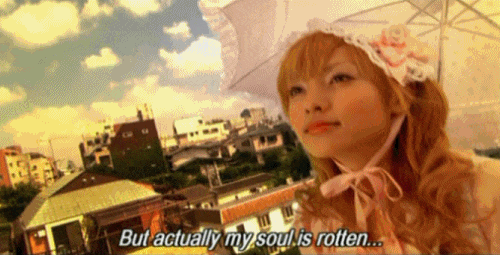Kamikaze Girls, or Shimotsuma Monogatari (meaning “Shimotsuma Story”) is a 2004 film directed by Tetsuya Nakashima based on a light novel by author Novala Takemoto. It focuses on the friendship between two very different teenage girls. Momoko, a girl obsessed with lolita fashion, and Ichigo, a girl in a delinquent biker gang. The two come from two very different subcultures, but they soon develop an unlikely friendship. In this review I will be discussing why I love this movie and the aspects of Japanese culture that can be learned from this film.
The Story

This film centers around Momoko and Ichigo, two unlikely friends who live in a rural city called Shimotsuma. The two are very different from each other, but they set out together in search for a legendary tailor in hopes that they can fix a spelling error on Ichigo’s jacket, and in time they soon come to realize that while they are different, they both are going through a similar struggle of trying to find one’s place in a society that they don’t fit into. This film at its core is a story about female friendship. In today’s media, there is no shortage of stories focused around male friendships, but it is quite rare and refreshing to see a film like this that is especially focused on a strong friendship between two girls without a whole lot of male characters. We see these two characters help each other and grow as people through their friendship. At the beginning of the film, Momoko is a very solitary person who doesn’t believe that friendship is necessary, but by the end of the film, she realizes that she is most happy when she is with her friend. Similarly, Ichigo feels out of place in Shimotsuma, and while she puts on tough appearances, she is struggling on the inside with figuring out who she really is. This movie is a feel good coming of age story that explores female friendship and youth subcultures of the early 2000s.
Japanese Culture
This movie has many aspects about it that makes it distinctly Japanese. This movie has a strong focus on the subcultures that were prominent in Japan around the time of its release. The first of course being Lolita fashion, a subculture and fashion movement in Japan that was heavily influenced by Rococo period France. Lolita fashion still exists today, but it was at its peak in the late 90’s and early 2000’s. One of the central hubs for the growth of Lolita fashion was Harajuku, Tokyo’s fashion district. One of the main internal struggles of the film is the fact that Momoko lives not in Tokyo but in the countryside, making her feel out of place among many of the older people in her town. Lolita fashion could be quite expensive, and because of this many fans of Lolita fashion would take a do-it-yourself approach, learning how to make their own clothes. This is an important aspect of the movie, because Momoko’s ability to design clothes is what kickstarts her friendship with Ichigo. The other subculture featured prominently in this film is juvenile delinquent gangs in japan, who are referred to as yankī in Japanese. Yankī is a pretty general term, but it is also associated with a specific kind of fashion, which can be seen by the different outfits that Ichigo wears throughout the movie.
The two subcultures of Lolita fashion and yankī biker gangs are polar opposites from each other. Lolita fashion focuses on being cutesy and princessy, while yankī fashion is all about being tough and strong. This juxtaposition between two polar opposite subcultures is part of what makes this film so charming.
What I Liked

One thing about this film that really stood out to me is the stylish editing and cinematography. Aside from this movie having a nice feel-good story, I think that this movie is worth watching just for it’s editing and cinematography alone. For example, there are a few moments in the film where Momoko imagines herself floating in the air, and every time it happened I was blown away just by how cool it looked. Another scene that stuck out to me was the scene where Momoko gets hit by a truck. It’s not just the specific stand out scenes either. The wide shots of the countryside and the eye-popping bubbly colors give this film a very unique atmosphere that I haven’t seen anywhere else. If you want to get a good idea of the style of this movie, I’d highly suggest looking through some of the photos on the film’s IMDb page. Here is one of my favorite shots from the movie:
If I had to describe this movie in one word it would be “style”, and if I had to describe this movie in nine words it would be “hyper stylized early 2000s quirky coming of age story”.
Final Thoughts
Overall I’d say that this is a very good coming of age film and I would recommend it to anyone looking for a wholesome and delightfully strange movie about friendship, or for anyone looking for a window into what Japanese subcultures were like in the early 2000s. The highlights of this film for me are the visuals, the dialogue, and the quirky characters. I personally can’t think of any major complaints about this film, but if you are not a fan of coming of age stories or can’t appreciate film that puts a focus on highly stylized editing, then maybe you won’t love it as much as I do. Either way I could still recommend it if you were looking for a light hearted movie that will put a smile on your face.



